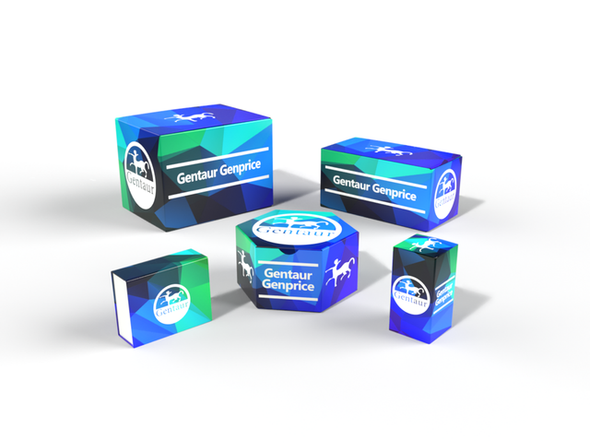749
Human ATP-binding cassette sub-family C member 9 (ABCC9) ELISA Kit | KTE60864
- SKU:
- 749-KTE60864
- Availability:
- Usually ships in 5 working days
Description
Human ATP-binding cassette sub-family C member 9 (ABCC9) ELISA Kit | KTE60864 | Gentaur UK, US & Europe Distribution
Application: This Human ATP-binding cassette sub-family C member 9 (ABCC9) ELISA Kit employs a two-site sandwich ELISA to quantitate ABCC9 in samples. An antibody specific for ABCC9 has been pre-coated onto a microplate. Standards and samples are pipetted into the wells and anyABCC9 present is bound by the immobilized antibody. After removing any unbound substances, a biotin-conjugated antibody specific for ABCC9 is added to the wells. After washing, Streptavidin conjugated Horseradish Peroxidase (HRP) is added to the wells. Following a wash to remove any unbound avidin-enzyme reagent, a substrate solution is added to the wells and color develops in proportion to the amount of ABCC9 bound in the initial step. The color development is stopped and the intensity of the color is measured.
Detection Method: Colorimetric
Conjugate: N/A
Sample Type: Cell culture supernatants#Serum#Plasma#Other biological fluids
Assay Type: Multiple steps standard sandwich ELISA assay with a working time of 3-5 hours. It depends on the experience of the operation person.
Kit Component: • Human ATP-binding cassette sub-family C member 9 microplate
• Human ATP-binding cassette sub-family C member 9 standard
• Human ATP-binding cassette sub-family C member 9 detect antibody
• Streptavidin-HRP
• Standard diluent
• Assay buffer
• HRP substrate
• Stop solution
• Wash buffer
• Plate covers
Features & Benefits: Human ATP-binding cassette sub-family C member 9 (ABCC9) ELISA Kit has high sensitivity and excellent specificity for detection of Human ABCC9. No significant cross-reactivity or interference between Human ABCC9 and analogues was observed.
Calibration Range: Please inquire
Limit Of Detection: Please inquire
Usage Note: • Do not mix components from different kit lots or use reagents beyond the kit expiration date.
• Allow all reagents to warm to room temperature for at least 30 minutes before opening.
• Pre-rinse the pipet tip with reagent, use fresh pipet tips for each sample, standard and reagent to avoid contamination.
• Unused wells must be kept desiccated at 4 °C in the sealed bag provided.
• Mix Thoroughly is very important for the result. It is recommended using low frequency oscillator or slight hand shaking every 10 minutes.
• It is recommended that all samples and standards be assayed in duplicate or triplicate.
Storage Instruction: The unopened kit should be stored at 2 - 8°C. After opening, please store refer to protocols.
Shipping: Gel pack with blue ice.
Precaution The product listed herein is for research use only and is not intended for use in human or clinical diagnosis. Suggested applications of our products are not recommendations to use our products in violation of any patent or as a license. We cannot be responsible for patent infringements or other violations that may occur with the use of this product.
Background: ATP-binding cassette, sub-family C member 9 (ABCC9) also known as sulfonylurea receptor 2 (SUR2) is an ATP-binding cassette transporter that in humans is encoded by the ABCC9 gene.The protein encoded by this gene is a member of the superfamily of ATP-binding cassette (ABC) transporters. ABC proteins transport various molecules across extra- and intra-cellular membranes. ABC genes are divided into seven distinct subfamilies (ABC1, MDR/TAP, MRP, ALD, OABP, GCN20, White) . This protein is a member of the MRP subfamily which is involved in multi-drug resistance. This protein is thought to form ATP-sensitive potassium channels in cardiac, skeletal, and vascular and non-vascular smooth muscle. Protein structure suggests a role as the drug-binding channel-modulating subunit of the extrapancreatic ATP-sensitive potassium channels. Alternative splicing of this gene results in several products, two of which result from differential usage of two terminal exons and one of which results from exon deletion.
Alternative Names: ABCC9; ABC37; CMD1O; FLJ36852; SUR2; ATP-binding cassette; sub-family C; member 9; sulfonylurea receptor 2A
Search name: ABCC9; ABC37; CMD1O; FLJ36852; SUR2; ATP-binding cassette; sub-family C; member 9; sulfonylurea receptor 2A
Tag: ABCC9






